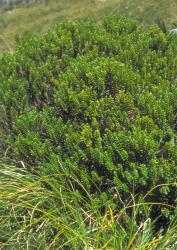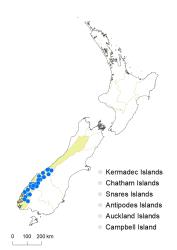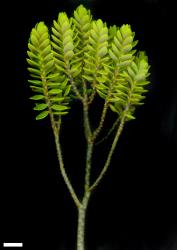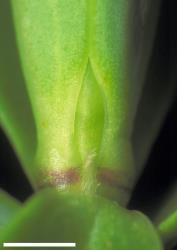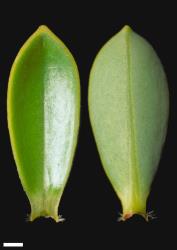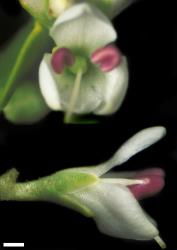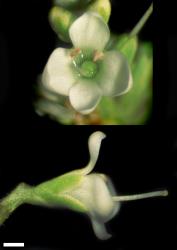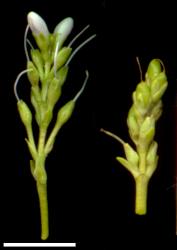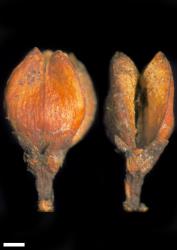- ≡ Hebe cockayneana (Cheeseman) Cockayne & Allan, Trans. New Zealand Inst. 57: 32 (1926)
- = Veronica willcoxii Petrie, Trans. & Proc. New Zealand Inst. 45: 272 (1913)
- ≡ Hebe willcoxii (Petrie) Cockayne & Allan, Trans. New Zealand Inst. 57: 34 (1926)
Bushy or spreading shrub to 1.2 m tall. Stems erect, eglandular-pubescent; hairs bifarious. Leaf bud distinct, its outer leaves appressed at margins until fully grown; sinus narrow, acute. Leaves opposite-decussate to sub-distichous, erecto-patent to spreading; lamina coriaceous to rigid, usually elliptic or narrowly elliptic, sometimes obovate, 5–22 mm long, 3–9 mm wide, glossy green above, dull and glaucous beneath; midrib evident; surfaces glabrous or with eglandular hairs along midrib above; margin minutely papillate or sparsely glandular-ciliolate, entire; apex sub-acute and bluntly plicate-acuminate; base cuneate; petiole 0.5–2.0 mm long. Inflorescence a lateral raceme, 7–32 mm long; flowers crowded, 6–23, female or bisexual on separate plants, ⚥ > ♀; bracts opposite-decussate, deltoid to ovate, < to > pedicels; pedicels sub-erect to erecto-patent, 0.5–5.5 mm long, pubescent all around. Calyx lobes 4, anterior pair free or fused to ⅔-way, sub-acute to obtuse, 1.8–2.5 mm long, sub-equal, mixed glandular- and eglandular-ciliolate. Corolla 9–11 mm (⚥) or 5–7 mm (♀) diameter; tube white, 1–2.3 mm long, ≤ calyx, glabrous; lobes 4, white, sub-erect to spreading, sub-equal, broadly ovate to sub-orbicular, 4–5 mm (⚥) or 2–3 mm (♀) long, sub-acute to obtuse; nectar guides absent; stamen filaments white, 1.4–4.3 mm long; anthers magenta (pale in ♀ flowers). Style glabrous 1.5–7.0 mm long. Capsules latiseptate, sub-acute to obtuse, glabrous, 3.0–5.5 mm long, 2.2–3.3 mm at widest point. Seeds broadly ellipsoid, flattened, smooth, pale brown to brown, 1.1–1.2 mm long.
Veronica cockayneana is the only hebe in Fiordland and South Westland that has discolorous leaves. It is also characterised by long, stiff, tapering, golden or sordid, spreading stem hairs and glandular leaf margin hairs (when present) with brown clavate heads. Some plants are male-sterile and have small anthers; others are hermaphrodite. Its distribution overlaps with that of V. arganthera, which differs in its larger and concolorous leaves, crowded, very short, tapered eglandular hairs on leaf margins, white or yellowish anthers, and its cosexual populations. Two species in Nelson, V. simulans and V. cryptomorpha, resemble V. cockayneana quite closely.
South Island: South Westland from Lake Sweeney and the Mataketake Range south to Fiordland north of about Centre Pass and Green Lake, also in West Otago near the main divide.
Sub-alpine shrubland and grassland, occasionally in rocky places. Recorded elevations range from 600 to 1495 m.
Flowers: December–March; fruits: December–April.
2n = 120 (see Bayly & Kellow 2006, as Hebe cockayneana).
Veronica cockayneana is classified in V. subg. Pseudoveronica sect. Hebe and the informal group “Apertae” (small-leaved) (Albach & Meudt 2010; Bayly & Kellow 2006). It shares its hexaploid chromosome number with several other species, including in southern New Zealand V. dilatata, but V. dilatata has an ITS sequence that indicates a similarity with V. arganthera.



